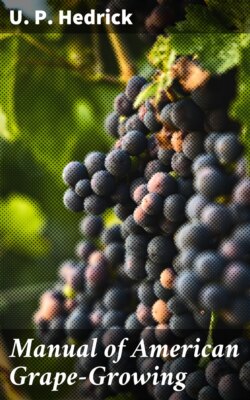Читать книгу Manual of American Grape-Growing - U. P. Hedrick - Страница 18
На сайте Литреса книга снята с продажи.
The Pacific slope.
ОглавлениеThe Pacific slope takes precedence among the grape regions of the continent, exceeding all others combined in the production of grapes and grape products. California is the viticultural center of this great region, grapes being grown within her bounds from the foot of Mount Shasta on the north to Mexico on the south and from the foothills of the Sierras on the east to the forest that borders the coast on the west. So outlined, California might appear to be one vast vineyard, but it is only in favored valleys, plains and low hills in the territory bounded that the vine is sufficiently well suited to be productive. Outliers of this main region of the Pacific slope run north into Oregon, Washington, Idaho and even into British Columbia, forced more and more eastward the farther north to escape humidity from the ocean which northward passes farther and farther inland. Other outliers of the main region are found eastward in Nevada, Arizona, New Mexico and even Utah and Colorado, though for the most part in these states grape-growing is still insignificant. Plate I shows typical vineyards in California.
The grapes grown on the Pacific slope are almost exclusively Vinifera varieties, though a few American grapes are planted in the Pacific Northwest. This is not because American varieties cannot be grown, although they succeed rather less well here than on the eastern seaboard, but because the Viniferas are liked better, and climate and soil seem exactly to suit them. Viticulture on the Pacific slope is divided into three interdependent industries which are almost never quite independent of each other—the wine industry, raisin industry and table-grape industry. Each of these industries depends on grapes more or less specially adapted to the product, the special characteristics being secured chiefly through somewhat distinct types of grapes but depending partly on soil and climatic conditions. The manufacture of unfermented grape-juice is not yet a success in this region for the reasons that Vinifera grapes do not make a good unfermented juice, and American grapes are not grown in sufficient quantities to warrant the establishment of grape-juice plants.
Bioletti gives the extent of the grape-growing industry in California as follows:[1]
"The vineyards of California covered in 1912 about 385,000 acres. Of this total, about 180,000 acres were producing wine-grapes. Roughly, 50 per cent of the wine was produced in the great interior valleys, including most of the sweet wines; 35 per cent was produced by the valleys and hillsides of the Coast ranges, including most of the dry wines; the remaining 15 per cent was produced in Southern California and included both sweet and dry.
"The raisin-grape vineyards covered about 130,000 acres, of which about 90 per cent were in the San Joaquin Valley, 7 per cent in the Sacramento, and 3 per cent in Southern California.
"The shipping-grape vineyards are reckoned at 75,000 acres, distributed about as follows: 50 per cent in the Sacramento Valley, 40 per cent in San Joaquin, 6 per cent in Southern California, and 4 per cent in the Coast ranges."
